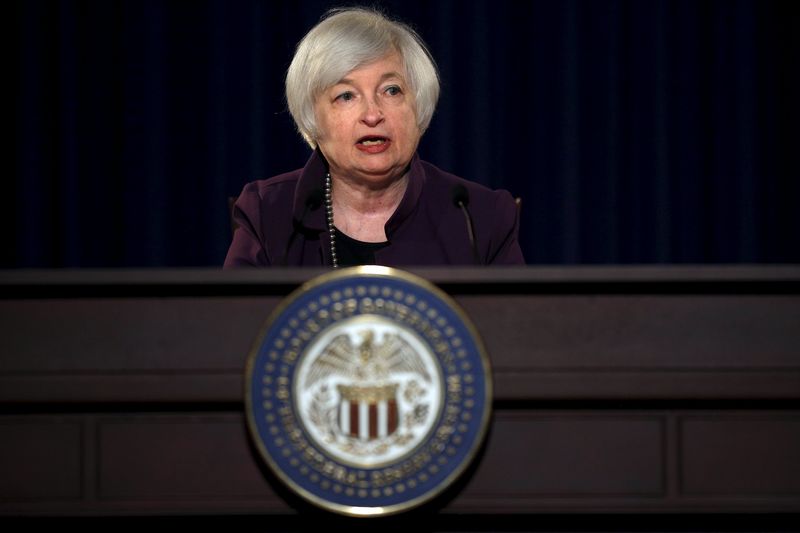Investing.com – While the large majority of market participants and experts expect no move in interest rates when the Federal Reserve (Fed) announces its monetary policy decision on Wednesday, they will pay close attention to the signals for the future path of tightening not only from the Fed members’ economic projections, but particularly from Janet Yellen’s press conference.
Economist surveys from various agencies all but ruled out any move in interest rates in the next meeting with the probability of a hike settling around 3% to 4%, depending on the poll.
Yet, the two-day meeting beginning on Tuesday was expected to be anything but a “non-event” with investors on edge to take signals not only from the statement itself but from the accompanying update in economic projections and remarks from the Fed Chair Janet Yellen in the posterior press conference.
Will the Fed think risks to the outlook are "nearly balanced" or "balanced"?
With regard to the Fed statement, focus is centered on the wording surrounding the outlook with most analysts debating whether the U.S. central bank will choose to consider the risks to be “nearly balanced” or “balanced”.
While global growth continues to be weak, solid readings from U.S. data since the beginning of the year such as January retail sales and industrial production or February’s employment report may give the Fed room to continue the tightening cycle kick-started with the first rate hike in nearly a decade last December.
27% of economists in a recent Bloomberg survey felt that Fed officials could upgrade the outlook to “nearly balanced” with another 16% opting for “balanced”. These changes could imply the possibility of a hike in June while leaving even April on the table.
Markets will look for shifts in the Fed’s forecasts for rate hikes
Another key factor for market participants to watch will be the update to economic projections (which most experts expect to reveal lower forecasts for growth and inflation), with a special focus on the Fed officials forecasts for interest rate moves known as the “dot plot” where individual Fed members’ anonymous estimates for the federal funds rate are plotted out over time.
Morgan Stanley (NYSE:MS) expects the “dot plot to shift lower, with a median at three hikes (for this year) and mean closer to two” compared to December’s graph showing four hikes for 2016.
However, Morgan Stanley took a more dovish few as the broker recently lowered its expectations for rate hikes to only one increase of 25 basis points (bp) in “late 2016” and 50 bp in 2017, from an earlier forecast of 75 and 100 bp, respectively.
To the contrary, Goldman Sachs (NYSE:GS) held a more hawkish view and expects three 25 bp hikes in 2016 with the first arriving at the June meeting.
June in focus for rate hikes to continue
Both expert opinions and market surveys vary, with the consensus placing about around a 50% chance of a hike in June.
However, a recent Wall Street Journal survey showed that bets increased with 76% of economists polled expecting the hike at the June meeting, compared to just 60% in the February survey.
Bond guru and Allianz (DE:ALVG) SE chief economist Mohammed El-Erian expressed his opinion in an article written for Bloomberg that the Fed would remain cautious on economic developments, both global and domestic, but would note recent improvements in the American economy.
However, he summarized that the Fed “will guide the markets toward the possibility of more interest rate increases than are currently priced in by traders and investors”, although he specified that the central bank would do so in a “gentle manner”.
Despite the more dovish forecast, Morgan Stanley did point out that the Fed would most likely maintain a gradual removal of accommodative monetary policy.
“The end result (will be) a reactionary Fed that maintains a tightening bias, but stresses caution and gradualism around a more uncertain outlook,” these experts said.
As seen last week in opposing views from Fed governor Lael Brainard who felt inflation expectations were falling and Fed vice-chair Stanley Fischer who felt there may be signs of inflation accelerating, it appears that the future path of tightening will be determined from the results of the debate between the doves who are concerned about the fragility of the economy and are looking for evidence of inflationary pressure and the hawks who are concerned about the Fed falling behind the curve with regard to increased inflation.
To take a former Fed member’s opinion on the next rate move into account, Narayana Kocherlakota, summed up that “June seems certainly like a possibility”.
